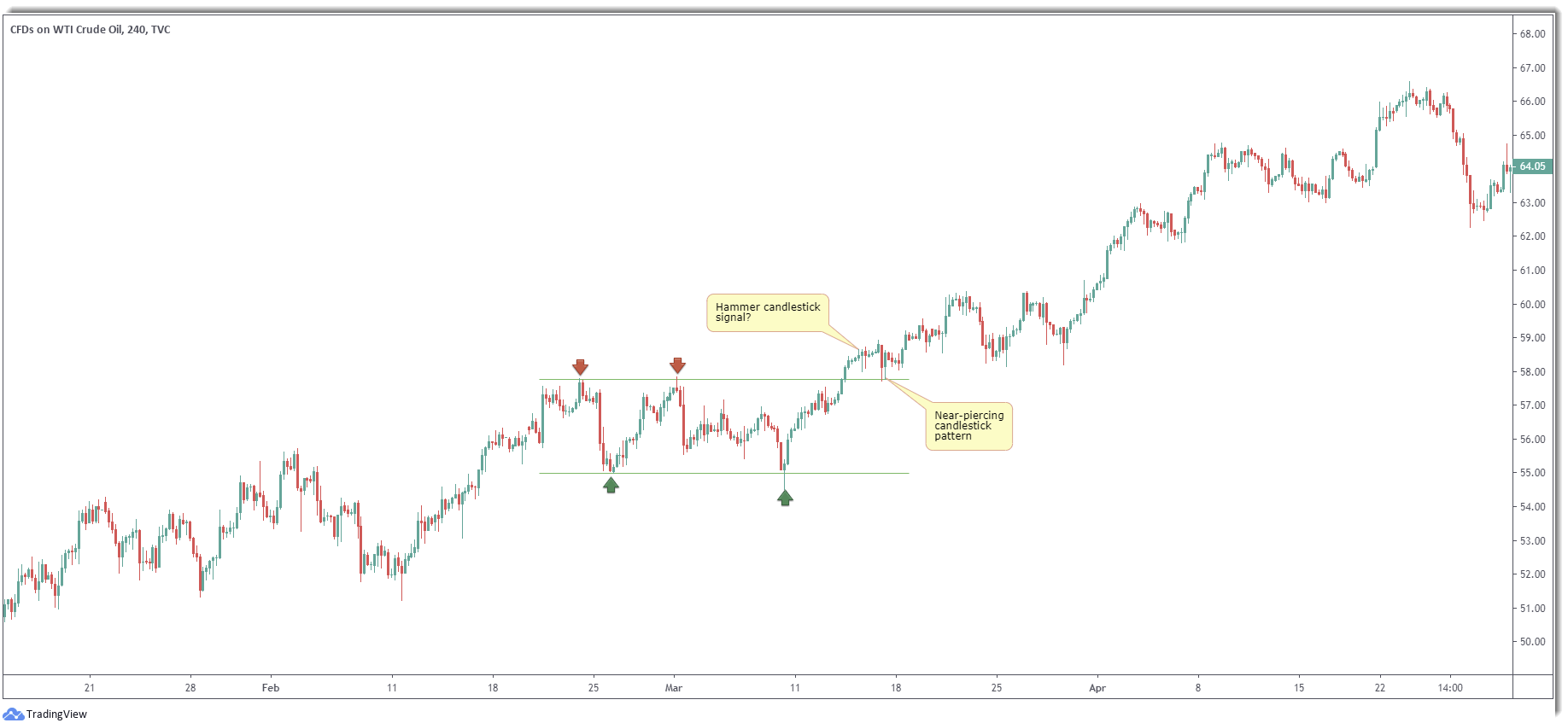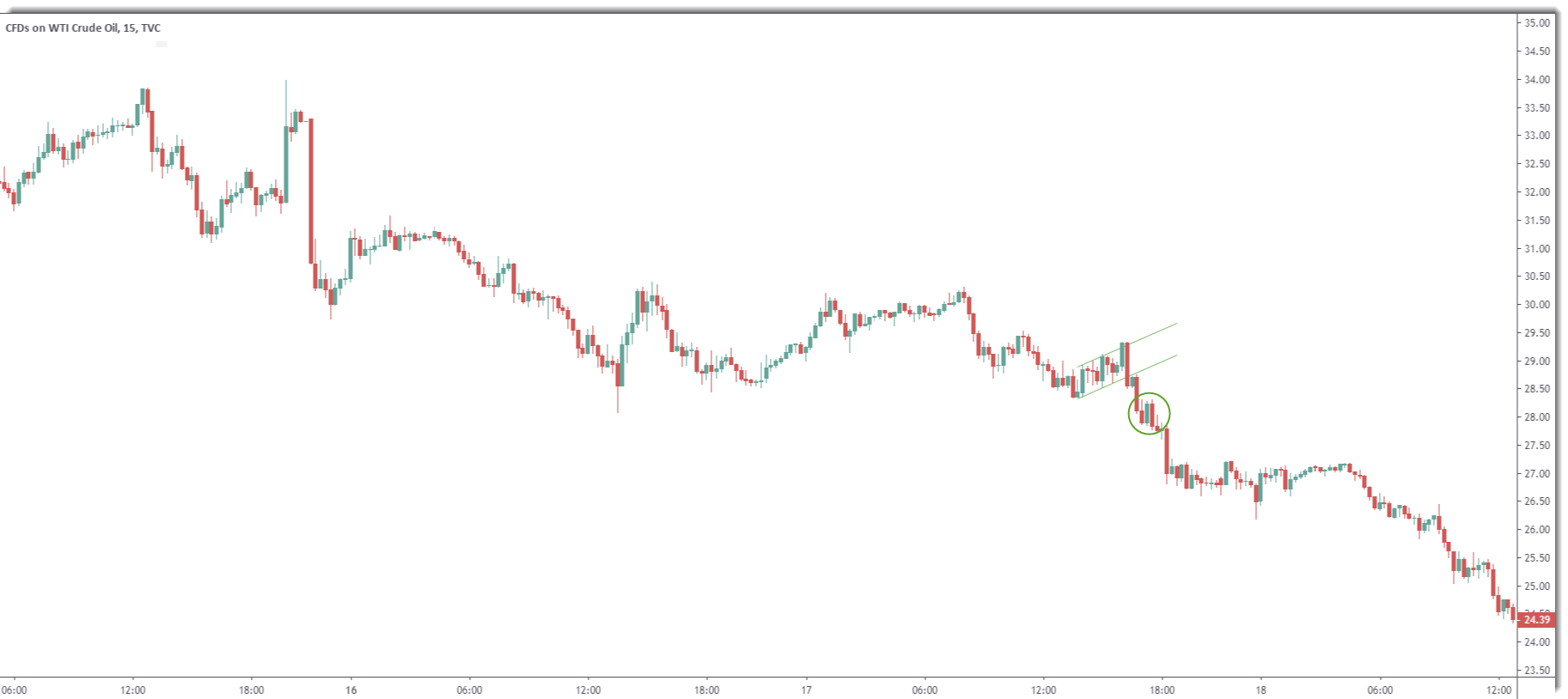Breakouts can generate high returns in Forex trading. It's no secret. Common as they are in the Forex market, though, they're difficult to forecast. Bull and bear traps frequently place traders on the wrong side of the market, leading to frustration and loss. Fortunately, techniques designed to help filter these breakout moves are available.
Breakouts
Currency markets consolidate and trend. Some analysts claim trends form between 20 to 30% of the time, with the remainder producing consolidations. To knowledge, no one has demonstrated the validity of this percentage.
When traders refer to trends, they're describing a directional trend, one of rising or falling price movement. Trading ranges, however, form when peaks/troughs group at equivalent price levels. The configuration can form at the beginning, mid-way through and at the end of trends. A trading range is also referred to as a congestion area or neutral zone. Trends and consolidations are also fractal in nature. Intraday price movement behaves similar to longer-term action, and vice versa.
Used as a basis to assess breakouts, several Forex chart patterns exist. These are generally labelled as continuation and reversal formations.
Double tops and bottom patterns are common in the Forex market. So are channels, either ascending channels, descending channels or horizontal channels. Other popular consolidation patterns are rising and falling wedges, bullish and bearish pennants as well as head and shoulder's (H&S) top and bottom configurations.
Range Trading
Although many within the field of technical analysis suggest range trading as a strategy, it's often difficult to pull off in live markets. It's tough to recognise a range until sufficient time passes, increasing the odds a breakout may occur. Additionally, fakeouts, or bull/bear traps, are common within ranging environments. These often whipsaw traders out of positions. This applies to short-term day trading, scalping, swing trading and position trading. As a result, most traders tend to avoid engaging within a congestion zone, and focus on the inevitable breakout and beginning of a trend. This is not to say successful range trading cannot be achieved. It can. Often though, it is within larger consolidations (rather than narrow trading ranges) that offer greater trading opportunity and more appealing risk/reward to the opposing range limit.
Breakout Trading
Breakout trading is lucrative, if on the right side of the market. A number of filters (breakout strategies) are in place to confirm the validity of a breakout. The close filter is popular – it involves waiting for a price close outside of the trading range. Some traders prefer a time filter. Rather than looking at price action, this method looks at time since penetration. Volume is another way to confirm a breakout, though difficult in the spot Forex market as its decentralised. In this case you'd have to rely on broker volume. Other traders look at closing prices beyond a moving average. Another method is the Pop and Stop trading strategy.
The Pop ‘n' Stop Trade
Price ‘pops' beyond a trading range limit – in the case of a Pop ‘n' Stop trade, a resistance level – and pauses, ‘stops', before resuming in the direction of the initial breakout.
At the point price movement pauses, traders seek candlestick signals that suggest continued direction. Most Forex traders rely on Japanese bullish candlestick signals, positioning buy-stop orders 1-2 points above the candlestick signals while positioning protective stop-loss orders beneath the formation. Of course, though, stop-loss order placement is trader dependent.
Figure 1.A illustrates a common horizontal trading channel on the H4 WTI Crude Oil price chart – peaks and troughs are almost at the same point. Once price closes outside of the congestion area, the ‘pop', movement pauses, the 'stop'. Shortly after the breakout, price chalked up a hammer candlestick pattern. While this pattern must form at troughs to be considered a bullish signal (some may feel it's simply a hanging man candlestick pattern [bearish]), many will note the fact back-to-back buying tails printed might be sufficient enough to glean interest. Price then chalked up a retracement and shaped a piercing candlestick pattern. For it to be a true piercing pattern, the second candle would have to open beneath the prior close. but considering the signal retested the top edge of the range, resistance-turned support, this may have been sufficient for most traders. The point here is you're looking for signs of bullish intent at the pause/stop. Entry above the candlestick patterns through a buy-stop order is, as underlined above, a common entry point, with protective stop-loss orders sited beneath the candle pattern's framework. Some, however, may choose more of a conservative route. Beneath the upper limit of the breached range, as price does not always retest the upper boundary as support prior to resuming upside, is popular.
The Drop ‘n' Stop Trade
The opposite of the Pop ‘n' Stop is the Drop ‘n' Stop Trade, employed to take advantage of breakouts to the downside. Both strategies are common within liquid trading sessions, such as London and the US (New York), particularly the overlap. Like the Pop ‘n' Stop, a Drop ‘n' Stop occurs when a currency pair declines from a consolidation and pauses before moving in a clear direction. Figure 1.B, the M15 price chart of WTI Crude Oil, reveals an example of an intraday M15 bearish flag pattern, a tight range generally viewed by many as a continuation signal. Following the breakout to the downside, a brief pause is immediately observed with another shortly after that. It is here traders seek entry, in this case by way of a bearish outside formation whereby the high/lows of the second candle engulfs that of the initial upside attempt (green circle). Entry on a sell-stop order was quickly filled; traders who plotted protective stop-loss levels according to the bearish pattern (a few points above the high of the structure) achieved lucrative risk/reward. Even those who positioned protective stop-loss orders above the bearish flag pattern's upper limit still realised an attractive risk/reward ratio.
Back Testing – Experimentation
Pop ‘n' Stop is a simple and effective breakout forex strategy (trading system), provided risk management and money-management principles are adhered to. Experimenting which approach fits your trading style is important; this is achieved through a back-testing trading platform, and demo trading account. It's an essential step before integrating any trading strategy into the live market. Although rejection bars/candles are favoured concerning entry at the stop, traders are free to experiment. Some prefer using Bollinger Bands and waiting for a close outside of the upper limit following the Pop ‘n' Stop. This includes a volatility factor. Others favour trendline breakouts, round numbers and Fibonacci pivots as additional confirmation. Another consideration is trading volume. Breakouts are generally more successful during London and US sessions, with the Asian segment typically pencilling in congestion areas. Do also take into account congestion areas form in a number of different chart patterns, not just the traditional horizontal channel, as demonstrated in figure 1.A. Traders are urged to research which consolidation pattern fits their trading style. For example, some prefer bullish and bearish flag patterns, as in figure 1.B, due to their simplistic nature; others favour head and shoulder's patterns – probably the most famous technical chart formation to grace the charts.
This material on this website is intended for illustrative purposes and general information only. It does not constitute financial advice nor does it take into account your investment objectives, financial situation or particular needs. Commission, interest, platform fees, dividends, variation margin and other fees and charges may apply to financial products or services available from FP Markets. The information in this website has been prepared without taking into account your personal objectives, financial situation or needs. You should consider the information in light of your objectives, financial situation and needs before making any decision about whether to acquire or dispose of any financial product. Contracts for Difference (CFDs) are derivatives and can be risky; losses can exceed your initial payment and you must be able to meet all margin calls as soon as they are made. When trading CFDs you do not own or have any rights to the CFDs underlying assets.
FP Markets recommends that you seek independent advice from an appropriately qualified person before deciding to invest in or dispose of a derivative. A Product Disclosure Statement for each of the financial products is available from FP Markets can be obtained either from this website or on request from our offices and should be considered before entering into transactions with us. First Prudential Markets Pty Ltd (ABN 16 112 600 281, AFS Licence No. 286354).
Editors’ Picks

EUR/USD ticks lower following the release of FOMC Minutes
The US Dollar found some near-term demand following the release of the FOMC meeting minutes, with the EUR/USD pair currently piercing the 1.1750 threshold. The document showed officials are still willing to trim interest rates. Meanwhile, thinned holiday trading keeps major pairs confined to familiar levels.

GBP/USD remains sub- 1.3500, remains in the red
The GBP/USD lost traction early in the American session, maintaining the sour tone and trading around 1.3460 following the release of the FOMC meeting minutes. Trading conditions remain thin ahead of the New Year holiday, limiting the pair's volatility.

Gold stable above $4,350 as the year comes to an end
Gold price got to recover some modest ground on Tuesday, holding on to intraday gains and changing hands at $4,360 a troy ounce in the American afternoon. The bright metal showed no reaction to the release of the FOMC December meeting minutes.

Ethereum: ETH holds above $2,900 despite rising selling activity
Ethereum (ETH) held the $2,900 level despite seeing increased selling pressure over the past week. The Exchange Netflow metric showed deposits outweighed withdrawals by about 400K ETH. The high value suggests rising selling activity amid the holiday season.

Bitcoin Price Annual Forecast: BTC holds long-term bullish structure heading into 2026
Bitcoin (BTC) is wrapping up 2025 as one of its most eventful years, defined by unprecedented institutional participation, major regulatory developments, and extreme price volatility.
RECOMMENDED LESSONS
Making money in forex is easy if you know how the bankers trade!
I’m often mystified in my educational forex articles why so many traders struggle to make consistent money out of forex trading. The answer has more to do with what they don’t know than what they do know. After working in investment banks for 20 years many of which were as a Chief trader its second knowledge how to extract cash out of the market.
5 Forex News Events You Need To Know
In the fast moving world of currency markets where huge moves can seemingly come from nowhere, it is extremely important for new traders to learn about the various economic indicators and forex news events and releases that shape the markets. Indeed, quickly getting a handle on which data to look out for, what it means, and how to trade it can see new traders quickly become far more profitable and sets up the road to long term success.
Top 10 Chart Patterns Every Trader Should Know
Chart patterns are one of the most effective trading tools for a trader. They are pure price-action, and form on the basis of underlying buying and selling pressure. Chart patterns have a proven track-record, and traders use them to identify continuation or reversal signals, to open positions and identify price targets.
7 Ways to Avoid Forex Scams
The forex industry is recently seeing more and more scams. Here are 7 ways to avoid losing your money in such scams: Forex scams are becoming frequent. Michael Greenberg reports on luxurious expenses, including a submarine bought from the money taken from forex traders. Here’s another report of a forex fraud. So, how can we avoid falling in such forex scams?
What Are the 10 Fatal Mistakes Traders Make
Trading is exciting. Trading is hard. Trading is extremely hard. Some say that it takes more than 10,000 hours to master. Others believe that trading is the way to quick riches. They might be both wrong. What is important to know that no matter how experienced you are, mistakes will be part of the trading process.
The challenge: Timing the market and trader psychology
Successful trading often comes down to timing – entering and exiting trades at the right moments. Yet timing the market is notoriously difficult, largely because human psychology can derail even the best plans. Two powerful emotions in particular – fear and greed – tend to drive trading decisions off course.




